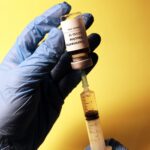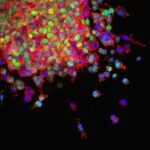SYNONIMS: Sanfilippo disease
ICD10 code: E76.2
ORPHANET number: ORPHA581
For more information about this disease, please visit the Orphanet website.
Visitors from North America may also contact NIH Office of Rare Diseases Research website.
SYNONIMS: Sanfilippo disease
ICD10 code: E76.2
ORPHANET number: ORPHA581
For more information about this disease, please visit the Orphanet website.
Visitors from North America may also contact NIH Office of Rare Diseases Research website.
 In the context of the widespread use of mRNA vaccines worldwide, the number of patients diagnosed with myocarditis is also increasing. Due to the pronounced heterogeneity in the clinical course of this disease, its diagnosis can easily be missed. The majority of reported cases are in young men between the ages of 15 and 29 after complete immunization cycle. The clinical case presented by us is of a 33-year-old man with a history of perimyocarditis 8 years ago and complaints after administration of the first dose of mRNA. Early diagnosis of myocarditis allows an early initiation of cardioprotective therapy, which reduces the risk of developing sudden cardiac death and improves the prognosis in these patients. Read the full article here.
In the context of the widespread use of mRNA vaccines worldwide, the number of patients diagnosed with myocarditis is also increasing. Due to the pronounced heterogeneity in the clinical course of this disease, its diagnosis can easily be missed. The majority of reported cases are in young men between the ages of 15 and 29 after complete immunization cycle. The clinical case presented by us is of a 33-year-old man with a history of perimyocarditis 8 years ago and complaints after administration of the first dose of mRNA. Early diagnosis of myocarditis allows an early initiation of cardioprotective therapy, which reduces the risk of developing sudden cardiac death and improves the prognosis in these patients. Read the full article here.
 On 1 October 2021 an international public-private consortium of 35 partners announced the launch of Screen4Care – a research project that aims to significantly shorten the time required for rare disease diagnosis and efficient intervention by utilising genetic newborn screening and advanced analysis methods such as machine learning. Read the full article here.
On 1 October 2021 an international public-private consortium of 35 partners announced the launch of Screen4Care – a research project that aims to significantly shorten the time required for rare disease diagnosis and efficient intervention by utilising genetic newborn screening and advanced analysis methods such as machine learning. Read the full article here.
 The technological revolution and the understanding of the molecular genetics, together with the pharmacological industry led to an improvement in the management of many diseases in medicine. In the recent decades, many fatal in the past cancers were cured or turned into chronic diseases. However, this is not always the case in rare oncological diseases. Despite the discrepancy in the different definitions of rare oncological diseases, epidemiological data show that, taken together, the estimated annual incidence of all rare cancers is more than 20% of all cancer diagnoses.The analysis of rare cancer burden is a key to their better diagnosis, treatment. It is also known that their registration is suboptimal, particularly in the countries of Eastern Europe. The leading problems in oncology are related to the diagnosis and detection of tumors, unlike other rare non-oncological diseases, and this worsens many clinical parameters. It is already known that survival and many clinical outcomes in treatment and follow-up are improved in specialized centers, which is expert management of these patients in specialized centers is highly recommended. A conceptual model for a functioning specialised center has already been elaborated. Read the full article here.
The technological revolution and the understanding of the molecular genetics, together with the pharmacological industry led to an improvement in the management of many diseases in medicine. In the recent decades, many fatal in the past cancers were cured or turned into chronic diseases. However, this is not always the case in rare oncological diseases. Despite the discrepancy in the different definitions of rare oncological diseases, epidemiological data show that, taken together, the estimated annual incidence of all rare cancers is more than 20% of all cancer diagnoses.The analysis of rare cancer burden is a key to their better diagnosis, treatment. It is also known that their registration is suboptimal, particularly in the countries of Eastern Europe. The leading problems in oncology are related to the diagnosis and detection of tumors, unlike other rare non-oncological diseases, and this worsens many clinical parameters. It is already known that survival and many clinical outcomes in treatment and follow-up are improved in specialized centers, which is expert management of these patients in specialized centers is highly recommended. A conceptual model for a functioning specialised center has already been elaborated. Read the full article here.
 Acanthosis nigricans (AN) is a rare congenital or acquired secondary skin disease characterized by darkening (hyperpigmentation) and thickening (hyperkeratosis) of the skin. The folds are symmetrically involved: plaques with the morphological characteristics of AN are found in the armpit (axilla), groin and back of the neck. It is subdivided into benign (“pseudoacanthosis nigricans”) and malignant AN.We present a case of a 43-year-old woman with AN with localized symmetrically pigmented plaques with a papillomatous surface in the axils, nape, back of the feet. The patient has clinical manifestations of grade III obesity (BMI > 40 kg/m2) and insulin-resistant diabetes with a duration of more than 10 years. Hypothyroidism, acromegaly, polycystic ovary and Cushing’s disease are excluded. Screening for visceral neoplasia was performed. The family survey did not reveal any manifestation of AN among the relatives.AN is most likely caused by factors that stimulate the proliferation of keratinocytes in the epidermis and fibroblasts in the dermis. In the benign form of AN, such a factor is probably insulin or insulin-like growth factor (IGF), which stimulates the growth of epidermal cells. Tyrosine kinase receptors (epidermal growth factor receptor or fibroblast growth factor receptor) also play a role. At high concentrations, insulin exerts a potent proliferative effect by binding with high affinity to IGF-1 receptors. In addition, free IGF-1 levels may be elevated in obese patients with hyperinsulinemia, leading to accelerated cell growth and differentiation. The case presented is illustrative of a rare dermatosis, which may be congenital or a paraneoplastic dermadrome. Read the full article here.
Acanthosis nigricans (AN) is a rare congenital or acquired secondary skin disease characterized by darkening (hyperpigmentation) and thickening (hyperkeratosis) of the skin. The folds are symmetrically involved: plaques with the morphological characteristics of AN are found in the armpit (axilla), groin and back of the neck. It is subdivided into benign (“pseudoacanthosis nigricans”) and malignant AN.We present a case of a 43-year-old woman with AN with localized symmetrically pigmented plaques with a papillomatous surface in the axils, nape, back of the feet. The patient has clinical manifestations of grade III obesity (BMI > 40 kg/m2) and insulin-resistant diabetes with a duration of more than 10 years. Hypothyroidism, acromegaly, polycystic ovary and Cushing’s disease are excluded. Screening for visceral neoplasia was performed. The family survey did not reveal any manifestation of AN among the relatives.AN is most likely caused by factors that stimulate the proliferation of keratinocytes in the epidermis and fibroblasts in the dermis. In the benign form of AN, such a factor is probably insulin or insulin-like growth factor (IGF), which stimulates the growth of epidermal cells. Tyrosine kinase receptors (epidermal growth factor receptor or fibroblast growth factor receptor) also play a role. At high concentrations, insulin exerts a potent proliferative effect by binding with high affinity to IGF-1 receptors. In addition, free IGF-1 levels may be elevated in obese patients with hyperinsulinemia, leading to accelerated cell growth and differentiation. The case presented is illustrative of a rare dermatosis, which may be congenital or a paraneoplastic dermadrome. Read the full article here.
 Mastocytosis (M) represents a heterogeneous disease characterized by increased accumulation and clonal proliferation of mast cells in the skin and/or different organs. Broadly, M is classified into two categories: cutaneous mastocytosis (CM) and systemic mastocytosis (SM). In children, CM is the most frequent form, but the lesions differ in clinical forms. We present a clinical case of a boy of 1 year and 4 months, who at 4 months of age after a severe allergic reaction was diagnosed with a solitary mastocytoma, confirmed by skin biopsy. Mastocytoma was noticed by the parents 4 days after birth. The patient has elevated levels of histamine and serum tryptase. Genetic marker KIT D816V in the blood is negative.Children often suffer from mast cell mediator-related symptoms. Severe hypersensitivity reactions can also occur, mostly in patients with extensive skin lesions and blistering. The evaluation of the pediatric patient with CM usually comprises laboratory exams, a skin biopsy and a complete clinical evaluation. It is also defining to distinguish between CM and other diseases with cutaneous involvement. The management of CM in childhood is mainly based on strict avoidance of triggers. The available cures are oral H1 and/or H2 antihistamines, oral cromolyn sodium, photochemotherapy, potent dermatocorticoid, calcineurin inhibitors and equipment of patients and their families with adrenaline autoinjector for use in severe anaphylactic reactions. In children, the prognosis of CM is excellent and in the majority of the cases the skin lesions regress spontaneously around puberty. Тhe heterogeneous symptoms of the various subvariants of mastocytosis require multidisciplinary cooperation and comprehensive care. Read the full article here.
Mastocytosis (M) represents a heterogeneous disease characterized by increased accumulation and clonal proliferation of mast cells in the skin and/or different organs. Broadly, M is classified into two categories: cutaneous mastocytosis (CM) and systemic mastocytosis (SM). In children, CM is the most frequent form, but the lesions differ in clinical forms. We present a clinical case of a boy of 1 year and 4 months, who at 4 months of age after a severe allergic reaction was diagnosed with a solitary mastocytoma, confirmed by skin biopsy. Mastocytoma was noticed by the parents 4 days after birth. The patient has elevated levels of histamine and serum tryptase. Genetic marker KIT D816V in the blood is negative.Children often suffer from mast cell mediator-related symptoms. Severe hypersensitivity reactions can also occur, mostly in patients with extensive skin lesions and blistering. The evaluation of the pediatric patient with CM usually comprises laboratory exams, a skin biopsy and a complete clinical evaluation. It is also defining to distinguish between CM and other diseases with cutaneous involvement. The management of CM in childhood is mainly based on strict avoidance of triggers. The available cures are oral H1 and/or H2 antihistamines, oral cromolyn sodium, photochemotherapy, potent dermatocorticoid, calcineurin inhibitors and equipment of patients and their families with adrenaline autoinjector for use in severe anaphylactic reactions. In children, the prognosis of CM is excellent and in the majority of the cases the skin lesions regress spontaneously around puberty. Тhe heterogeneous symptoms of the various subvariants of mastocytosis require multidisciplinary cooperation and comprehensive care. Read the full article here.
 An important breakthrough in the negotiations between the European Parliament and the EU Council regarding the scope and content of the future EU Health Technology Assessment (HTA) regulations was announced on 22nd June 2021. This agreement was anticipated as an important step towards achieving numerous goals, including improved access to innovative therapies for EU patients and more efficient use of the available health resources in the Member States. What exactly happened on that date and what should we expect to follow? Read the full article here.
An important breakthrough in the negotiations between the European Parliament and the EU Council regarding the scope and content of the future EU Health Technology Assessment (HTA) regulations was announced on 22nd June 2021. This agreement was anticipated as an important step towards achieving numerous goals, including improved access to innovative therapies for EU patients and more efficient use of the available health resources in the Member States. What exactly happened on that date and what should we expect to follow? Read the full article here.
 Celiac disease is an autoimmune systemic disorder, predominantly affecting the small intestine resulting in chronic inflammation. It is associated with gluten ingestion – a protein ingredient of wheat, rye, barley and oats. Susceptible and genetically predisposed individuals develop the disease in childhood or in adolescence. Common symptoms include diarrhea and signs of malabsorption, but the disease could occur with atypical manifestations such as anemia, dermatitis, osteopenia, infertility, nervous system involvement, behavioral disorders.Rare cases of acute onset of the disease in adulthood are published in the literature – celiac crisis. In this case typical are metabolic dysregulation, dyselectrolytemia, neurological disorders and higher mortality. We present a clinical case of a 39-year-old female patient with acute onset of the disease, anemia, diarrhea, electrolyte disorders, tetany, limb paresis. Serological, endoscopic and histologic findings confirm the diagnosis celiac disease. Gluten-free diet was then introduced, which led to clinical recovery. Read the full article here.
Celiac disease is an autoimmune systemic disorder, predominantly affecting the small intestine resulting in chronic inflammation. It is associated with gluten ingestion – a protein ingredient of wheat, rye, barley and oats. Susceptible and genetically predisposed individuals develop the disease in childhood or in adolescence. Common symptoms include diarrhea and signs of malabsorption, but the disease could occur with atypical manifestations such as anemia, dermatitis, osteopenia, infertility, nervous system involvement, behavioral disorders.Rare cases of acute onset of the disease in adulthood are published in the literature – celiac crisis. In this case typical are metabolic dysregulation, dyselectrolytemia, neurological disorders and higher mortality. We present a clinical case of a 39-year-old female patient with acute onset of the disease, anemia, diarrhea, electrolyte disorders, tetany, limb paresis. Serological, endoscopic and histologic findings confirm the diagnosis celiac disease. Gluten-free diet was then introduced, which led to clinical recovery. Read the full article here.
 On 10-11 September 2021, for 12th consecutive year, the Institute for Rare Diseases has organised the the National Conference for Rare Diseases and Orphan Drugs. The conference is an annual forum that brings together all stakeholders – health care professionals, patients, medical students, health authorities and industry. This year, 46 speakers took part in the Scientific Program and presented current topics related to innovations in the diagnosis, treatment and follow-up care for patients with rare diseases, the development of European reference networks and all latest news related to access to innovation. The Poster session included 29 scientific posters on various topics related to rare diseases. More than 80 interactive materials and videos accessible 24/7 are presented at the Virtual Booths of the Institute for Rare Diseases, the National Alliance of People with Rare Diseases and our industry partners.
On 10-11 September 2021, for 12th consecutive year, the Institute for Rare Diseases has organised the the National Conference for Rare Diseases and Orphan Drugs. The conference is an annual forum that brings together all stakeholders – health care professionals, patients, medical students, health authorities and industry. This year, 46 speakers took part in the Scientific Program and presented current topics related to innovations in the diagnosis, treatment and follow-up care for patients with rare diseases, the development of European reference networks and all latest news related to access to innovation. The Poster session included 29 scientific posters on various topics related to rare diseases. More than 80 interactive materials and videos accessible 24/7 are presented at the Virtual Booths of the Institute for Rare Diseases, the National Alliance of People with Rare Diseases and our industry partners.
The registered conference participants will have the opportunity, within the month of September, to view all recordings of the lectures, Scientific Posters and to visit the digital materials available at the Virtual Booths in the Virtual Congress Venue.
Sorry, this entry is only available in Bulgarian.
